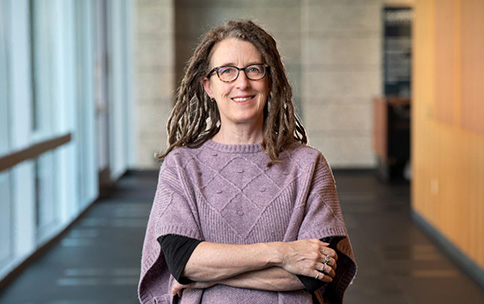
Modeling Nuclear DNA to Understand our Hearts, Brains, and Beyond
The microscopic DNA inside our cells, packaged into a structure called chromatin, is impossible to see with the naked eye. However, changes in chromatin arrangement in different cells might affect entire organs, though the processes underlying these effects remain largely unknown. For example, the most common type of birth defects are congenital heart defects, which are often linked to genetic mutations and can require extensive treatment and surgeries for affected children. 4D Nucleome (4DN) researcher Dr. Katherine Pollard, along with a team of 4DN researchers at the Gladstone Institutes, aims to uncover how chromatin organization changes as heart cells develop. Her research involves studying stem cells, which could mature into heart cells, and measuring how different regions of chromatin interact with each other during this maturation process. These data are used to build deep learning models that can predict how chromatin will fold within the cellular nucleus and what the effect of genetic variations may be, shedding light on the cellular mechanisms that link chromatin organization to heart cell function. By predicting changes in how a mutation will affect chromatin organization, this model could help provide diagnoses of the underlying issues behind a heart defect, and open new possibilities for targeted treatments.
These models will not only be useful to predict effects of mutations on heart cells, says Dr. Pollard; her lab has already begun studying models of childhood brain cancer and autism spectrum disorders to understand how chromatin organization affects those diseases. As part of the 4DN predictive modeling working group, Dr. Pollard’s work has been enhanced by the ability to get feedback from other researchers doing similar work across many institutions. 4DN has not only aided her work by building connections to other scientists but has also generated new methods to sequence the genome and map how chromatin is organized within the cellular nucleus. As building predictive models of the genome requires large amounts of data, progress in measuring and mapping chromatin are critical to advancing her work.
Dr. Pollard advises that, to find success in research as well as a scientific career, it is important to follow your passions, and “sometimes that means doing things that aren’t the well-trodden path.” Throughout her career, she has followed her scientific interests though the fields of anthropology, math, computer science, and biology, building strong networks of other women researchers in fields that used to have much less representation. When she was beginning her research career, the field of genome-wide bioinformatics didn’t exist: the human genome was sequenced for the first time during her graduate studies. “Science moves really quickly, technology moves really quickly,” says Dr. Pollard, “and what you’ll be doing ten to twenty years from now is really hard to predict.”
Learn more about Dr. Pollard’s research here.
Photo: Michael Short/Gladstone Institutes


